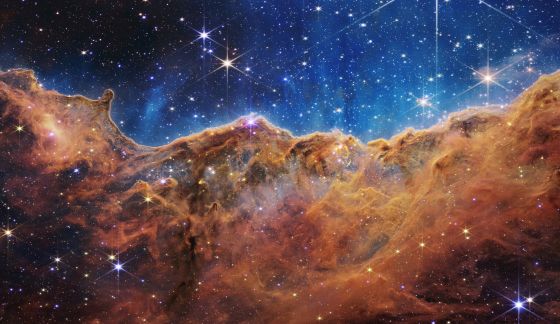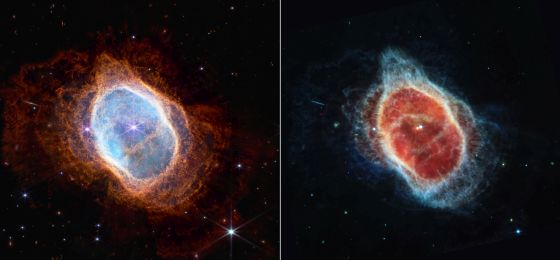A large number of photos of the deep space taken by the James Webb Space Telescope have been released, and finally the photos of the 5 celestial bodies of the initial event are available.

NASA has released four astrophotography of deep space taken with the ultra-high performance space telescope '
First Images from the James Webb Space Telescope | NASA
https://www.nasa.gov/webbfirstimages
NASA Reveals Webb Telescope's First Images of Unseen Universe | NASA
https://www.nasa.gov/press-release/nasa-reveals-webb-telescope-s-first-images-of-unseen-universe
The James Webb Space Telescope is a space telescope developed at a cost of 1 trillion yen as a successor to the Hubble Space Telescope . The James Webb Space Telescope was launched in December 2021, and after that, adjustment work was carried out in nanometer units for various devices while overcoming accidents such as the collision of meteorites , and the main work was carried out on July 11, 2022. Photos of the galaxy 'SMACS 0723' taken with the sensors ' Near Infrared Camera (NIRCam) ' and ' Mid-Infrared Instrument (MIRI) ' have been released.
Finally, the first color photo taken by James Webb Space Telescope is released, and the amazing performance of thousands of galaxies-GIGAZINE

And on July 13, 2022, there will be color photographs of the targets of the initial shooting events other than 'SMACS 0723', 'Carina Nebula', 'Southern Ring Nebula', 'Stephan's Quintet Galaxy', and 'WASP-96 b'. It has been published. You can see the high-resolution version released by NASA by clicking the four photos below.
◆ Eta Carina Nebula
Below is a picture of the 'Carina Nebula' taken by the James Webb Space Telescope. The place where the photo was taken is the star formation area 'NGC 3324' of the 'Carina Nebula', and the brown moyamoya in the lower part of the photo is the hot dust and gas flowing out of the nebula. Although there are a large number of stars in the process of formation in 'NGC 3324', it has been difficult to observe rapidly changing stars in the formation by conventional observation methods. However, the James Webb Space Telescope has extremely high sensitivity, resolution, and imaging performance, so the stars in the process of formation are reflected as 'red dots' in the brown moyamoya. NASA said, 'Until now, it has been difficult for astronomers to obtain data on young stars in the process of formation. With the James Webb Space Telescope, it is now possible to obtain complete data on the stars in the process of formation. I will. '

◆ South Ring Nebula
Below is a photo of the 'Southern Ring Nebula' about 2500 light-years away from Earth, with NIRCam on the left and MIRI on the right. NIRCam and MIRI can visualize light of different wavelengths, which makes the pictures they take look different. Focusing on the central part of the photo taken of the 'Southern Ring Nebula', one bright star is shown in the photo taken with NIRCam (left), but the color is different in the photo taken with MIRI (right). There are two stars in the picture. According to NASA, the darker of the two stars has reached the end of life, releasing gas and dust to its surroundings. It is also believed that the brighter stars will begin to emit gas and dust in the future. The red and white dots in the periphery of the photo are not stars but galaxies.

◆ Stephan's Quintet Galaxy
'Stephan's Quintet Galaxy' is known for its close proximity to each other, especially the upper 'NGC 7319' and the middle right 'NGC 7318A' 'NGC 7318B' and the lower 'NGC 7317'. Is known to be physically linked. Looking at the photo, it seems that the galaxy 'NGC 7320' on the left side of the middle row is also in a fairly close position, but 'NGC 7320' is located on the front side when viewed from the earth, and it is far from other galaxies. I am. The picture of 'Stephan's Quintet Galaxy' taken by the James Webb Space Telescope is composed of about 1000 image files, and the total number of pixels exceeds 150 million pixels.

◆ WASP-96 b
'WASP-96b' is a celestial body located 1500 light-years away from the earth, and is considered to be 'the best target for observing the state of the atmosphere' due to the short orbital period and the small number of light sources in the vicinity. .. NASA observed the atmosphere of 'WASP-96b' using the spectroscopic observation sensor ' Near-Infrared Imager and Slitless Spectrograph (NIRISS) ' mounted on the James Webb Space Telescope, and detailed data on the water present in the atmosphere. Succeeded in getting. NIRISS can observe a wider range of wavelengths than the spectroscopic observation equipment used so far, and can detect very slight differences in brightness. For this reason, the observation data of 'WASP-96b' by the James Webb Space Telescope captures the characteristics of the atmosphere in more detail than the existing observation data.

'The equipment (of the James Webb Space Telescope) worked perfectly and nature was incredibly beautiful,' said John Mother, senior project scientist at the James Webb Space Telescope Project. Thanks to the teams around the world for making it possible. '
Related Posts:
in Science, Posted by log1o_hf






